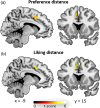The neural representation of metacognition in preferential decision-making
- PMID: 38646963
- PMCID: PMC11033923
- DOI: 10.1002/hbm.26651
The neural representation of metacognition in preferential decision-making
Abstract
Humans regularly assess the quality of their judgements, which helps them adjust their behaviours. Metacognition is the ability to accurately evaluate one's own judgements, and it is assessed by comparing objective task performance with subjective confidence report in perceptual decisions. However, for preferential decisions, assessing metacognition in preference-based decisions is difficult because it depends on subjective goals rather than the objective criterion. Here, we develop a new index that integrates choice, reaction time, and confidence report to quantify trial-by-trial metacognitive sensitivity in preference judgements. We found that the dorsomedial prefrontal cortex (dmPFC) and the right anterior insular were more activated when participants made bad metacognitive evaluations. Our study suggests a crucial role of the dmPFC-insula network in representing online metacognitive sensitivity in preferential decisions.
Keywords: confidence; metacognition; neural representation; preferential decision‐making.
© 2024 The Authors. Human Brain Mapping published by Wiley Periodicals LLC.
Conflict of interest statement
The authors declare no competing interests.
Figures





Similar articles
-
Neural correlates of metacognitive ability and of feeling confident: a large-scale fMRI study.Soc Cogn Affect Neurosci. 2016 Dec;11(12):1942-1951. doi: 10.1093/scan/nsw093. Epub 2016 Jul 21. Soc Cogn Affect Neurosci. 2016. PMID: 27445213 Free PMC article.
-
The neural system of metacognition accompanying decision-making in the prefrontal cortex.PLoS Biol. 2018 Apr 23;16(4):e2004037. doi: 10.1371/journal.pbio.2004037. eCollection 2018 Apr. PLoS Biol. 2018. PMID: 29684004 Free PMC article.
-
Moral conviction interacts with metacognitive ability in modulating neural activity during sociopolitical decision-making.Cogn Affect Behav Neurosci. 2025 Apr;25(2):291-310. doi: 10.3758/s13415-024-01243-3. Epub 2024 Dec 19. Cogn Affect Behav Neurosci. 2025. PMID: 39702726
-
Thinking about thinking: A coordinate-based meta-analysis of neuroimaging studies of metacognitive judgements.Brain Neurosci Adv. 2018 Nov 13;2:2398212818810591. doi: 10.1177/2398212818810591. eCollection 2018. Brain Neurosci Adv. 2018. PMID: 30542659 Free PMC article. Review.
-
Optimal metacognitive decision strategies in signal detection theory.Psychon Bull Rev. 2025 Jun;32(3):1041-1069. doi: 10.3758/s13423-024-02510-7. Epub 2024 Nov 18. Psychon Bull Rev. 2025. PMID: 39557811 Free PMC article. Review.
References
-
- Bastin, J. , Deman, P. , David, O. , Gueguen, M. , Benis, D. , Minotti, L. , Hoffman, D. , Combrisson, E. , Kujala, J. , Perrone‐Bertolotti, M. , Kahane, P. , Lachaux, J.‐P. , & Jerbi, K. (2017). Direct recordings from human anterior insula reveal its leading role within the error‐monitoring network. Cerebral Cortex, 27(2), 1545–1557. - PubMed
-
- Bud Craig, A. D. (2009). How do you feel—Now? The anterior insula and human awareness. Nature Reviews Neuroscience, 10(1), 59–70. - PubMed
-
- Craig, A. D. (2002). How do you feel? Interoception: The sense of the physiological condition of the body. Nature Reviews Neuroscience, 3(8), 655–666. - PubMed
Publication types
MeSH terms
Grants and funding
LinkOut - more resources
Full Text Sources
Medical
Research Materials

